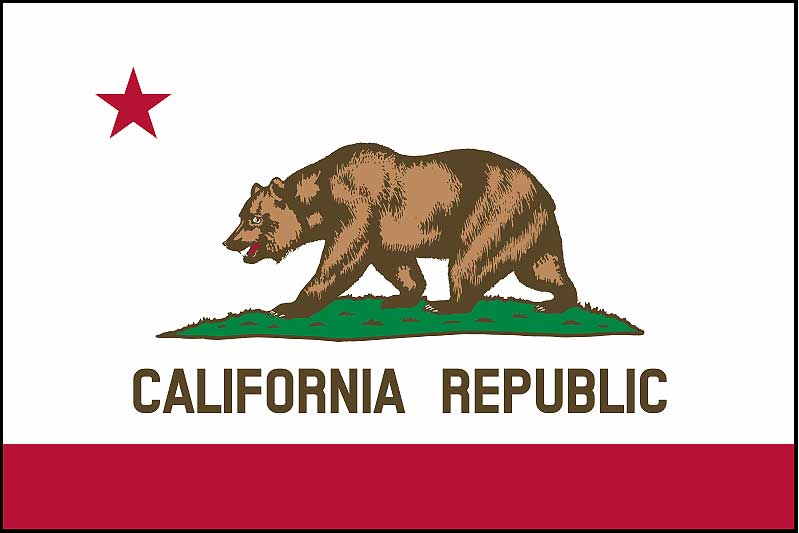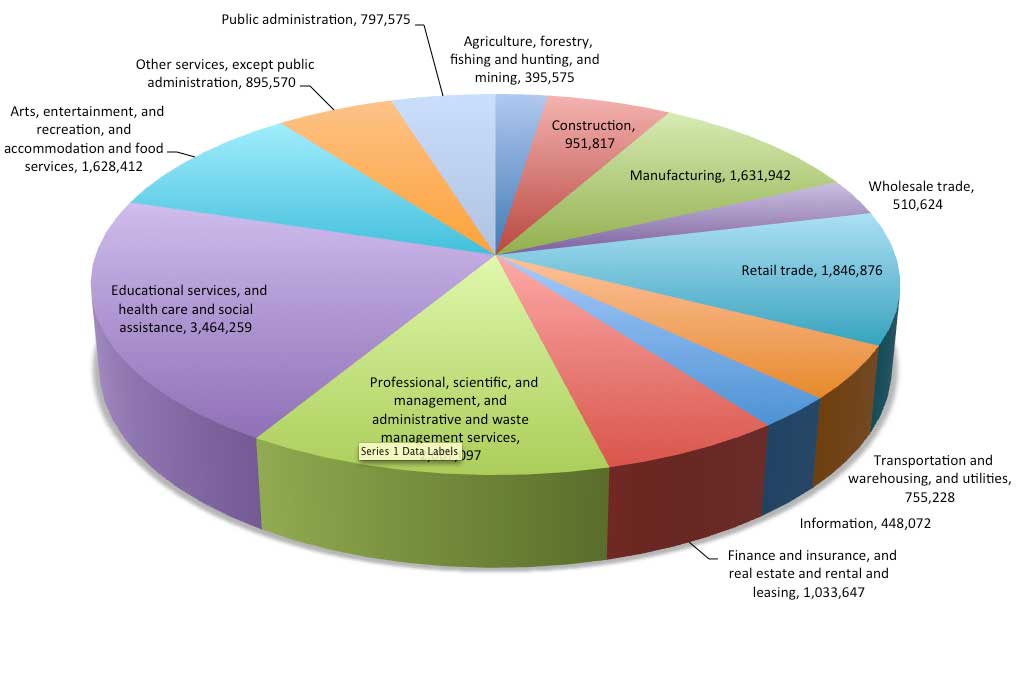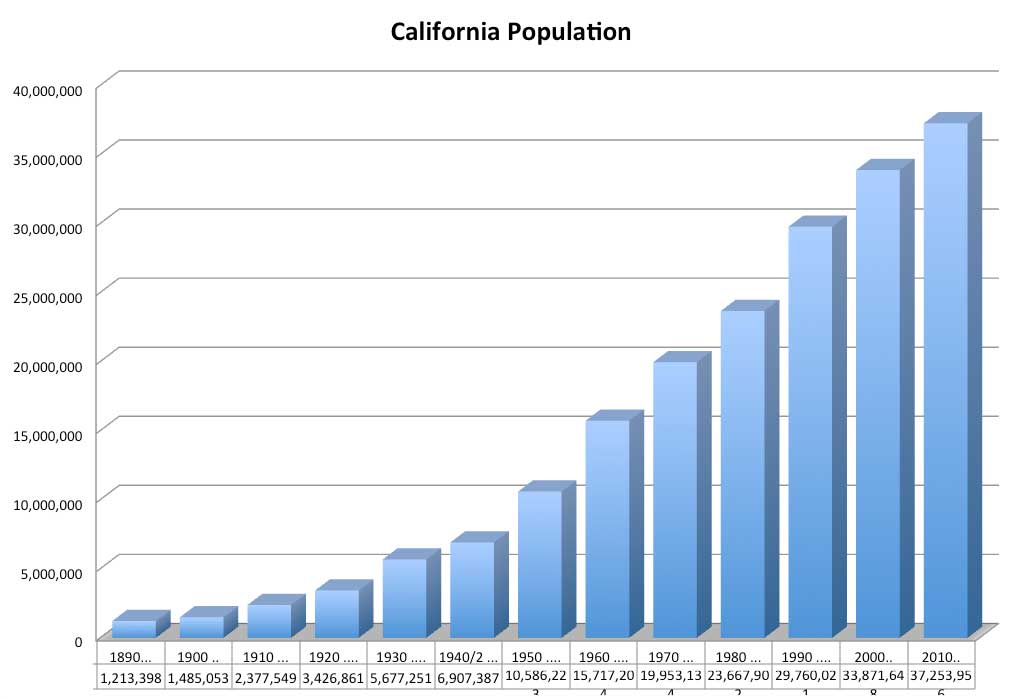California


Basic Information
Postal Abbreviation: CA
Natives: Californian
Population 2020: 39,538,223
Legal Driving Age: 16
Age of Majority: 18
Median Age: 36.1
State Song: “I Love You, California”
Music & Lyrics: F.B. Sherwood and
A.F. Frankenstein
Median Household Income:$67,269
Capital..... Sacramento
Entered Union..... Sept. 9, 1850 (31st)
Present Constitution Adopted: 1879
Nickname: The Golden State
Motto:
“Eureka” (I found it)
Origin of Name:
Named after a fictional island in a Spanish novel written by Garcia Ordonez de Montalvo in 1510. The name was given by explorer Hernando Cortes, early in the 16th century.
Railroad Stations
BB 44 USS California
California Economy
AGRICULTURE: cattle, cotton, field
crops, fruits, milk, poultry, vegetables.
MINING: boron, cement, clay gypsum,
gold, limestone, petroleum, sand and
grave.
MANUFACTURING: aerospace, aircraft,
computers, computer software,
electronics, food processing.
Major Companies by Revenue
Major Universities
UCLA

California Geography
Total Area: 163,707 sq. miles
Land area: 155,973 sq. miles
Water Area: 7,734 sq. miles
Geographic Center: Madera County
35 mi. NE of Madera
Highest Point: Mount Whitney* Tulare County
(14,494 ft. above sea level)
* This is the highest point in the continental US
Lowest Point: Death Valley*(–282 ft.)
* This is the lowest point in North America
Highest Recorded Temp.: 134˚ F (7/10/1913)
Lowest Recorded Temp.: -45˚ F (1/20/1937)
California is traversed by two mountain ranges, the Coastal Range and the Sierra Nevada. The valley between them is California’s Central Valley. Thanks to extensive irrigation the central valley is one of the richest farmlands in the country. The coastal area of the northern part of the state is covered by redwood forests, while the southern part of the state is desert– containing among others, Death Valley. The California Pacific coast extends 840 miles from the Mexican border to Oregon.
Cities
Los Angeles, 3,990,456
San Diego, 1,425,976
San Jose, 1,030,119;
San Francisco, 883,305;
Fresno, 530,093
Sacramento, 508,529;
Long Beach, 467,354;
Oakland, 429,082;
Bakersfield, 383,579;
Anaheim, 352,005
Counties
California History
1533 California first explored by Spanish
1769 A mission was established at San Diego.
1776 A mission was established in San Francisco.
1797 The first church was built at San Juan Capistrano.
1814 John Gilroy jumped ship and became the first non spanish settlers.
1824 Jedediah Smith arrived in California after leading the first overland
expedition to California.
1836 California declared its independence from Mexico.
1841 The first wagon train of settlers arrived via the Oregon Trial.
1846 As part of the Mexican American War Commodore D Sloat raised the
American flag in Monterry and claimed California for the United States.
1847 Spanish troops surrendered.
1848 Gold was discovered at Sutters Mill setting off the California Gold Rush.
1850 California is admitted to the Union.
1860 The Pony Express begins delivery of mail to California from St Joseph
Missouri.
1868 Completion of the transcontinental railroad in opened the
way for rapid transportation to California from the east.
1906 Most of San Francisco was leveled in an earthquake.
1911 The first motion picture studio moved to Hollywood Hills.
1955 Disneyland opened in Anaheim.
1965 Blacks who rioted in the Watts ghetto of Los Angeles, 34 deaths resulted.
1967 Students at UCLA Berkely were at the forefront of the anti war movement.
1968 Robert Kennedy was assassinated in Los Angeles.
1973 Thomas Bradely became the first Black mayor of LA.
1. 1984 - Los Angeles Summer Olympics
The Summer Olympic Games were held in Los Angeles, marking the city’s second time hosting the event (the first being in 1932).
1992 - Los Angeles Riots
Following the acquittal of four police officers in the beating of Rodney King, Los Angeles erupted into widespread riots, resulting in over 50 deaths, thousands of injuries, and significant damage to the city.
1994 - Northridge Earthquake
A magnitude 6.7 earthquake struck the San Fernando Valley region of Los Angeles, causing extensive damage, killing 57 people, and injuring thousands. It remains one of the most destructive and costly earthquakes in U.S. history.
2018 - Camp Fire, California’s Deadliest Wildfire
The Camp Fire in Northern California became the deadliest and most destructive wildfire in the state’s history, killing 85 people and devastating the town of Paradise.
Famous People
Ansel Adams
Joe DiMaggio
Robert Frost
William Randolph Hearst
Steve Jobs
Allen Lockheed
Marilyn Monroe
Adlai Stevenson
John Steinbeck
Edward Teller
Shirley Temple
Earl Warren

California National Sites
1) Alcatraz Island
California is traversed by two mountain ranges, the Coastal Range and the Sierra Nevada. The valley between them is California’s Central Valley. Thanks to extensive irrigation the central valley is one of the richest farmlands in the country. The coastal area of the northern part of the state is covered by redwood forests, while the southern part of the state is desert– containing among others, Death Valley. The California Pacific coast extends 840 miles from the Mexican border to Oregon.
2) Old Sacramento
Old Sacramento State Historic Park is located within the Old Sacramento Historic District of Sacramento, California. It is generally referred to as Old Sacramento, or Old Sac, and since the 1960s has been restored and developed as a significant tourist attraction. The Old Sacramento Historic District is a U.S. National Historic Landmark District.
3) Yosemite National Park
First protected in 1864, Yosemite National Park is best known for its waterfalls, but within its nearly 1,200 square miles, you can find deep valleys, grand meadows, ancient giant sequoias, a vast wilderness area, and much more
4) Redwood National Park
The Redwood National and State Parks (RNSP) are located in the United States, along the coast of northern California. Comprising Redwood National Park (established 1968) and California's Del Norte Coast, Jedediah Smith, and Prairie Creek Redwoods State Parks (dating from the 1920s), the combined RNSP contain 133,000 acres (540 km2).[3] Located entirely within Del Norte and Humboldt Counties, the four parks, together, protect 45% of all remaining coast redwood (Sequoia sempervirens) old-growth forests, totaling at least 38,982 acres (157.75 km2)..
5)Sequoia National Park
Sequoia National Park is a national park in the southern Sierra Nevada east of Visalia, California, in the United States. It was established on September 25, 1890. The park spans 404,063 acres (631.35 sq mi; 1,635.18 km2).[1] Encompassing a vertical relief of nearly 13,000 feet (4,000 m), the park contains among its natural resources the highest point in the contiguous 48 United States, Mount Whitney, at 14,505 feet (4,421 m) above sea level.
6)Death Valley
Death Valley National Park is a national park in the U.S. states of California and Nevada located east of the Sierra Nevada, occupying an interface zone between the arid Great Basin and Mojave deserts in the United States. The park protects the northwest corner of the Mojave Desert and contains a diverse desert environment of salt-flats, sand dunes, badlands, valleys, canyons, and mountains. It is the largest national park in the lower 48 states and has been declared an International Biosphere Reserve. Approximately 95% of the park is a designated wilderness area
From Muscle Beach to Modern Gyms: The Evolution of Fitness Centers in California
 >
>